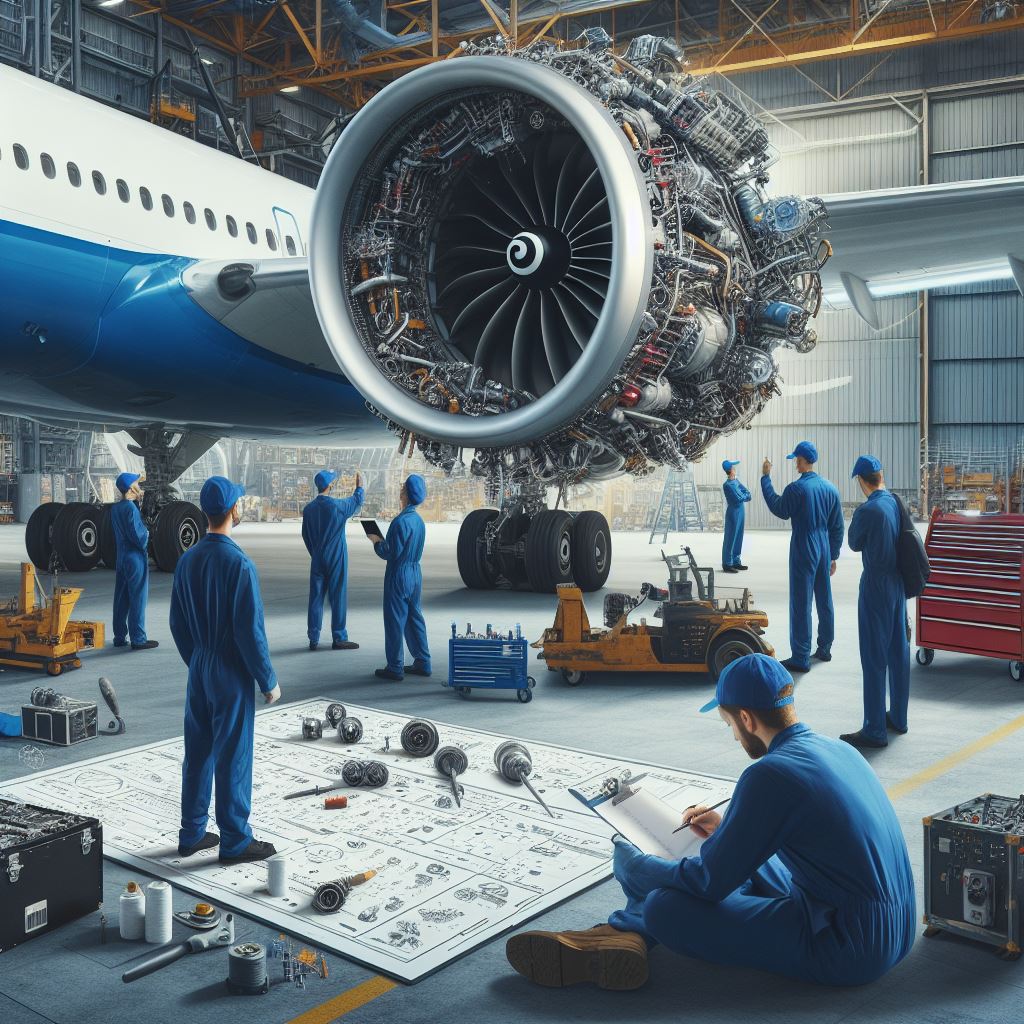For professionals in the aviation industry, understanding various documents is essential for ensuring safety, compliance, and operational efficiency. From maintenance manuals to regulatory directives, each document serves a crucial role in maintaining airworthiness and facilitating smooth operations. In this comprehensive overview, we'll explore key documents that every aviation professional should be familiar with, shedding light on their significance and impact on industry practices.
In the dynamic and highly regulated world of aviation, adherence to meticulous documentation is not just a formality—it's a necessity. Whether you're a seasoned aircraft engineer, a diligent maintenance technician, or a meticulous pilot, being well-versed in the array of documents that govern aviation operations is paramount. Let's embark on a journey through the essential documents that form the backbone of aviation maintenance, operations, and regulatory compliance. From Aircraft Maintenance Manuals to National Aviation Authority requirements, each document plays a vital role in ensuring the safety, airworthiness, and regulatory adherence of aircraft worldwide. Join us as we delve into this intricate landscape of aviation documentation, unraveling its complexities and unveiling its importance in the ever-evolving aviation industry.
For Everyone that work in aviation industry, there are several document that need to know of nice to know. I summarize on article below:
1. Aircraft Maintenance Manual (AMM): The AMM is a comprehensive document provided by the aircraft manufacturer. It contains detailed procedures, instructions, and guidelines for maintaining and repairing the specific aircraft model.
2. Aircraft Maintenance Program (AMP): The AMP outlines the maintenance tasks and intervals required for the aircraft. It includes scheduled inspections, component replacements, and other maintenance actions based on the aircraft's type, age, and operational history.
3. Minimum Equipment List (MEL): The MEL is an approved document that specifies the minimum equipment requirements for the aircraft to be considered airworthy. It outlines the permissible deferred maintenance items and provides procedures for operating the aircraft with inoperative equipment.
4. Aircraft Logbooks: The aircraft logbooks are an essential record-keeping system that documents the maintenance, repairs, modifications, and inspections performed on the aircraft throughout its operational life. This includes the Aircraft Maintenance Record (AMR), Engine Logbook, Airframe Logbook, and Component Logbooks.
5. Work Order or Job Card: A work order or job card is a document that provides detailed instructions for a specific maintenance task or action. It includes information such as the work to be performed, tools required, parts needed, and any additional instructions or precautions.
6. Maintenance Release or Certificate of Release to Service (CRS): The maintenance release is a document signed by a licensed aircraft maintenance engineer or authorized personnel, indicating that the maintenance task has been completed in accordance with the approved procedures and the aircraft is considered airworthy.
7. Service Bulletins (SB) and Airworthiness Directives (AD): SBs and ADs are issued by the aircraft manufacturer or aviation authority to address specific maintenance requirements, modifications, or inspections necessary for the continued airworthiness of the aircraft. Compliance with these documents is mandatory. Service Bulletins (SBs), issued by the aircraft manufacturer or Original Equipment Manufacturers (OEMs), although compliance isn't always mandatory, adhering to them when accomplished is required. Airworthiness Directives (ADs) are mandates issued by aviation authorities to address identified safety concerns. These directives can modify existing maintenance requirements or introduce new tasks.
8. Maintenance Manuals and Instructions: These include various manuals, such as the Structural Repair Manual (SRM), Wiring Diagram Manual (WDM), Illustrated Parts Catalog (IPC), and other specific manuals provided by the manufacturer. These manuals provide detailed instructions and information for maintenance, repairs, and troubleshooting.
9. Calibration Certificates: Calibration certificates are required for calibrated tools and equipment used in the maintenance process, such as torque wrenches, pressure gauges, and test equipment. These certificates ensure that the tools are accurate and provide reliable results.
10. Building a Boeing Aircraft Maintenance Program (AMP) is a multi-faceted process, essential for ensuring an aircraft's safety, airworthiness, and compliance with regulatory standards. This comprehensive approach involves integrating a variety of considerations and once created it needs to be maintained throughout the aircraft life.
11. The Maintenance Planning Document (MPD) is the foundation of the AMP, providing detailed guidelines for routine maintenance based on effectivity, configuration and status of the aircraft.
12. Supplemental Type Certificates (STCs) authorize modifications affecting the aircraft's type certification. Each STC includes specific ICAs that must be integrated into the AMP.
13. Modifications and repairs can introduce new maintenance requirements / ICAs, necessitating their documentation and incorporation into the AMP.
14. OEM (Original Equipment Manufacturer) Instructions for Continued Airworthiness (ICA) provide comprehensive maintenance procedures from the manufacturers, ensuring multiple components and equipment remain airworthy.
15. The Emergency Equipment Listing (EEL) details items you need ot review for ICA from OEM for critical safety equipment, such as life jackets based on the Component Maintenance Manuals (CMM) from equipment manufacturers.
16. National Aviation Authority (NAA) Requirements must also be considered, as local regulations can influence maintenance practices and schedules, necessitating adjustments to the AMP to ensure compliance.
17. Operational Environment Considerations, such as climate and flight routes, impact maintenance needs and schedules.
18. Reliability Data and Operator Experience play a role in maintenance practices. Historical data and experience can lead to adjustments in the AMP thresholds.
In conclusion, mastering the plethora of documents outlined in the aviation industry is not merely a task—it's a commitment to excellence, safety, and regulatory compliance. By understanding and adhering to these documents, aviation professionals uphold the highest standards of airworthiness and operational integrity. As we navigate the skies and strive for continuous improvement, let us remain diligent in our stewardship of these essential documents, ensuring the safety and reliability of aviation operations for generations to come.
In the dynamic and highly regulated world of aviation, adherence to meticulous documentation is not just a formality—it's a necessity. Whether you're a seasoned aircraft engineer, a diligent maintenance technician, or a meticulous pilot, being well-versed in the array of documents that govern aviation operations is paramount. Let's embark on a journey through the essential documents that form the backbone of aviation maintenance, operations, and regulatory compliance. From Aircraft Maintenance Manuals to National Aviation Authority requirements, each document plays a vital role in ensuring the safety, airworthiness, and regulatory adherence of aircraft worldwide. Join us as we delve into this intricate landscape of aviation documentation, unraveling its complexities and unveiling its importance in the ever-evolving aviation industry.
For Everyone that work in aviation industry, there are several document that need to know of nice to know. I summarize on article below:
1. Aircraft Maintenance Manual (AMM): The AMM is a comprehensive document provided by the aircraft manufacturer. It contains detailed procedures, instructions, and guidelines for maintaining and repairing the specific aircraft model.
2. Aircraft Maintenance Program (AMP): The AMP outlines the maintenance tasks and intervals required for the aircraft. It includes scheduled inspections, component replacements, and other maintenance actions based on the aircraft's type, age, and operational history.
3. Minimum Equipment List (MEL): The MEL is an approved document that specifies the minimum equipment requirements for the aircraft to be considered airworthy. It outlines the permissible deferred maintenance items and provides procedures for operating the aircraft with inoperative equipment.
4. Aircraft Logbooks: The aircraft logbooks are an essential record-keeping system that documents the maintenance, repairs, modifications, and inspections performed on the aircraft throughout its operational life. This includes the Aircraft Maintenance Record (AMR), Engine Logbook, Airframe Logbook, and Component Logbooks.
5. Work Order or Job Card: A work order or job card is a document that provides detailed instructions for a specific maintenance task or action. It includes information such as the work to be performed, tools required, parts needed, and any additional instructions or precautions.
6. Maintenance Release or Certificate of Release to Service (CRS): The maintenance release is a document signed by a licensed aircraft maintenance engineer or authorized personnel, indicating that the maintenance task has been completed in accordance with the approved procedures and the aircraft is considered airworthy.
7. Service Bulletins (SB) and Airworthiness Directives (AD): SBs and ADs are issued by the aircraft manufacturer or aviation authority to address specific maintenance requirements, modifications, or inspections necessary for the continued airworthiness of the aircraft. Compliance with these documents is mandatory. Service Bulletins (SBs), issued by the aircraft manufacturer or Original Equipment Manufacturers (OEMs), although compliance isn't always mandatory, adhering to them when accomplished is required. Airworthiness Directives (ADs) are mandates issued by aviation authorities to address identified safety concerns. These directives can modify existing maintenance requirements or introduce new tasks.
8. Maintenance Manuals and Instructions: These include various manuals, such as the Structural Repair Manual (SRM), Wiring Diagram Manual (WDM), Illustrated Parts Catalog (IPC), and other specific manuals provided by the manufacturer. These manuals provide detailed instructions and information for maintenance, repairs, and troubleshooting.
9. Calibration Certificates: Calibration certificates are required for calibrated tools and equipment used in the maintenance process, such as torque wrenches, pressure gauges, and test equipment. These certificates ensure that the tools are accurate and provide reliable results.
10. Building a Boeing Aircraft Maintenance Program (AMP) is a multi-faceted process, essential for ensuring an aircraft's safety, airworthiness, and compliance with regulatory standards. This comprehensive approach involves integrating a variety of considerations and once created it needs to be maintained throughout the aircraft life.
11. The Maintenance Planning Document (MPD) is the foundation of the AMP, providing detailed guidelines for routine maintenance based on effectivity, configuration and status of the aircraft.
12. Supplemental Type Certificates (STCs) authorize modifications affecting the aircraft's type certification. Each STC includes specific ICAs that must be integrated into the AMP.
13. Modifications and repairs can introduce new maintenance requirements / ICAs, necessitating their documentation and incorporation into the AMP.
14. OEM (Original Equipment Manufacturer) Instructions for Continued Airworthiness (ICA) provide comprehensive maintenance procedures from the manufacturers, ensuring multiple components and equipment remain airworthy.
15. The Emergency Equipment Listing (EEL) details items you need ot review for ICA from OEM for critical safety equipment, such as life jackets based on the Component Maintenance Manuals (CMM) from equipment manufacturers.
16. National Aviation Authority (NAA) Requirements must also be considered, as local regulations can influence maintenance practices and schedules, necessitating adjustments to the AMP to ensure compliance.
17. Operational Environment Considerations, such as climate and flight routes, impact maintenance needs and schedules.
18. Reliability Data and Operator Experience play a role in maintenance practices. Historical data and experience can lead to adjustments in the AMP thresholds.
In conclusion, mastering the plethora of documents outlined in the aviation industry is not merely a task—it's a commitment to excellence, safety, and regulatory compliance. By understanding and adhering to these documents, aviation professionals uphold the highest standards of airworthiness and operational integrity. As we navigate the skies and strive for continuous improvement, let us remain diligent in our stewardship of these essential documents, ensuring the safety and reliability of aviation operations for generations to come.


